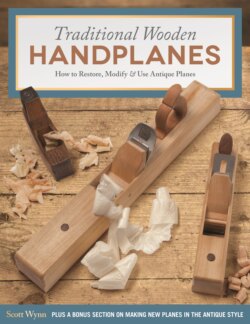Читать книгу Sew-It-Yourself Home Accessories - Scott Wynn - Страница 12
На сайте Литреса книга снята с продажи.
THE BLOCK
ОглавлениеThe basic block, or body of the traditional wood handplane has evolved into a few variations.
There is, of course, the basic block shape that is used for all the different types of these planes—jack, jointer, smoother—and on the larger versions, with an added handle or two. This shape may literally be a simple block with straight edges and sharp corners that appears to give no accommodation to the hands. I collected such a plane (the Goldenberg plane I mentioned earlier) because of its unusual blade and chipbreaker set-up, but also because its severe geometry seemed not just uncomfortable, but possibly damaging (Figure 1-8). It appears well used and taken care of, but it has all its straight rectangular corners intact, giving no suggestion of how you could push this plane—in the manner we are used to, like with a Stanley plane—without bruising your hands. This befuddled me. Then, just recently I saw (again) a video of the Swiss cooper Ruedi Kohler, filmed (coincidentally by Rick Mastelli, the technical editor and photographer of my first book) in 1992. In the film I noticed Herr Kohler used a series of hollowing planes to curve the inside of the staves. These planes were a plain block, not shaped, like the Goldenberg I had. But instead of using the planes one hand in front of the blade, the other behind, he gripped the planes on both sides, thumbs behind the blade and first fingers down flat on either side ahead of the blade. Mystery explained. This is very similar to the grip used for cross-handled Chinese and Southeast Asian planes. Without the cross handles it doesn’t seem to be a grip of great power like you might want in a jack plane to remove a lot of stock, but it provides sufficient power for smoothing and light shaving, especially in softer woods. The position also seems to give good control. It is most comfortable to use, however, when pushing straight ahead on short pieces; standing to one side as you might do when a piece is dogged onto the bench is more awkward with this symmetrical grip (Figure 1-9).
For smoothing planes that require more power, the coffin shape was developed (Figure 1-10). This configuration works pretty well for shorter smoothing planes, directing the energy efficiently forward and down, and giving wide distribution on the hand, even on the older planes that have not been particularly rounded off. The only real improvement I can see making here is to add a “thumbpiece” behind the blade to catch the crotch of the thumb and first finger; otherwise there is a tendency for the hand to ride up and chafe on the back of the blade.
Figure 1-11. Razee fore plane, 15" (38.1cm) long The term Razee derives from the French vaisseau rase, a wooden warship with the upper deck cut away. Razee planes have the top of the body cut away behind the blade, lowering the handle and reducing the weight.
The Razee (from the French vaiseau rase, a wooden warship with the upper deck cut away) style of plane has the top of the body cut away behind the blade, lowering the handle and reducing the weight (Figure 1-11). These were often used to train students and apprentices because it was felt the full block versions were not only heavy (you have to remember these kids were 13 to 15 years old and mostly pretty small), but also easier to control than the full-block versions. This is because the high position of the handle on the jointer plane, while initially awkward, once mastered, gives greater feedback as to the angle of the plane to the work when shooting an edge. This is basic geometry: the further away you are from the face of the work the more exaggerated the tilt must become in order to maintain the same angle. Thus it makes it easier to tell when you’re going out of square.
I find the reduced weight of the Razee style useful for preparatory planes such as the jack and fore plane. I also find it useful for my panel plane (more on this to come), because not only is it lighter, the low position of the handle gives good feedback when smoothing.
